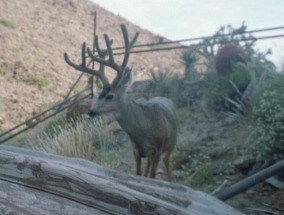
NPS Photo Do mule deer in Mojave National Preserve need more water? It may seem like a silly question. After all, it’s a desert—doesn’t everything need more water? Scientists at Mojave National Preserve are working with the California Department of Fish & Game (CDFG) and researchers at the University of Nevada-Reno to answer this question, and a few others. Why Mule Deer? Cattle Ranching With the establishment of Mojave National Preserve in 1994, hunting of mule deer (and other wildlife) continued to be permitted in accordance with CDFG regulations. Cattle ranching and grazing, too, continued to be permitted. Since then, several ranchers have willingly sold their lands and grazing rights, and their grazing allotments have been retired. These ranchers had the right to remove their personal property, including range improvements such as fences, water tanks, pipelines and windmills. The wells that were constructed to provide water for cattle were shut off. While annual buck kill data show a slight upward trend since 2001, some long-time residents and observers believe that mule deer and other wildlife populations had declined since cattle watering systems were shut down. Reduced grazing pressure, dramatic differences in annual precipitation and loss of water distribution systems for livestock are all factors that may be affecting deer populations. In 2004, CDFG, in cooperation with Safari Club International, Quail Unlimited, the California Deer Association, the Mule Deer Foundation, Desert Wildlife Unlimited, and the Foundation for North American Wild Sheep, proposed to retrofit or reactivate 12 retired ranching wells to provide water for deer and other wildlife. Environmental Assessment The links below provide further information on the project’s timeline, schedule, and background information, including documentation of its legislative and management history. Project Timeline and Schedule August 30, 2004 -- California Department of Fish and Game proposes to convert 12 abandoned livestock wells to wildlife guzzlers. June 6 - September, 2005 -- Mojave National Preserve completes an Environmental Assessment of the proposed conversion. April 19, 2006 -- The science-based management alternative is selected that will initiate research on water developments. June 2, 2006 -- Mojave National Preserve issues requests for proposals for artificial water manipulation and mule deer demography research. These were later combined into one study based on responses to the request. May 25, 2007 -- Following a conference call with the researchers we have asked for an extension. This will allow Dr. Kelley Stewart, the new large mammal biologist at UNR, time to come onboard. Dr. Bleich is completing analyses of existing data. Our deadline for an NPS funding proposal will be in November, 2007. November 13, 2007 -- Kelley Stewart et al. Responses of Mule Deer to Experimental Manipulation of Water Sources in Mojave National Preserve: A Research Proposal Submitted to the National Park Service. January 18-22, 2008 -- A helicopter capture effort sponsored by Safari Club International and coordinated by California Department of Fish and Game and University of Nevada, Reno captured 15 does, 2 bucks, and 1 yearling female mule deer in the Preserve. June 16, 2008 -- A Request for Quotes to activate five wells for Responses of Mule Deer to Experimental Manipulation of Water Sources in Mojave National Preserve was posted on FedBizOpps.gov. This request consists of a Statement of Work, Bid Sheet, a general location map, and a detailed map and runs through July 15, 2008. September 1, 2008 -- Five wells were reactivated for the first phase of the study of Responses of Mule Deer to Experimental Manipulation of Water Sources in Mojave National Preserve. These are Gold King, Petit, Government Holes, Hogaboom, and Eagle. Click on the links to view an image of each reactivated well. January 25-30, 2009 -- A helicopter capture effort sponsored by Safari Club International and coordinated by California Department of Fish and Game and University of Nevada, Reno captured 30 does and 1 yearling female mule deer in the Preserve. Refer to the Science Newsletter for more details. April 25-30, 2010 -- A helicopter capture effort sponsored by Safari Club International and coordinated by California Department of Fish and Game and University of Nevada, Reno capture 15 mule deer in the Preserve as described in the General Summary. Background Information See also California Department of Fish and Game website. Satellite image of Mojave National Preserve showing approximate mule deer habitat, locations of springs and seeps, and locations where motion-activated cameras have photographed mule deer. Graph of buck kill data for Zone D17 from 1959 through 2005. |
Last updated: April 11, 2024
